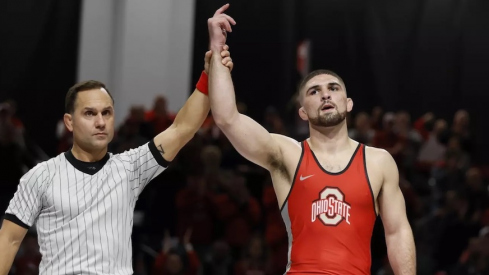Despite all the window dressing of spread formations and uptempo pace, Urban Meyer's offenses have always been smash-mouth rushing attacks at their core.
As this year's edition was busy putting on a running-game clinic midway in the second half of their final regular season contest, Meyer's offense would sneak in a wrinkle that went unnoticed by many. Given that Ezekiel Elliott's performance would be the headline of the Buckeyes' efforts that day, it's no surprise that a 12-yard run by Curtis Samuel didn't register with many viewers at the time.
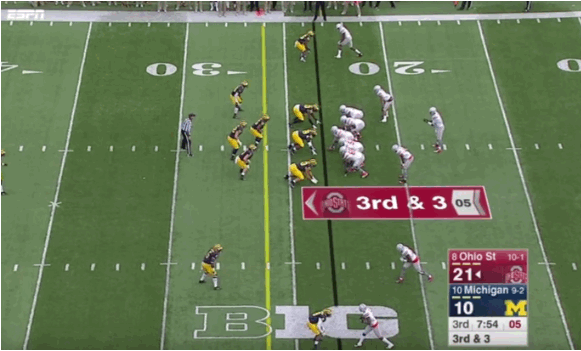
However, after taking a second look at this third-down conversion, we may have seen a new addition to Meyer's already-vaunted ground attack. The first thing we notice is the personnel and formation, in which quarterback J.T. Barrett is all alone in the backfield with Elliott standing on the sideline.
While running an 'empty' formation with five wide receivers isn't new for the Buckeyes, the alignment of receivers Jalin Marshall and Curtis Samuel certainly was. Each member of the duo is aligned as a wing, just to the outside of and a yard behind the tackle to their sides, flanking Barrett.
At the snap, the play happens so quickly that it appears to be a "speed option" to the left with Samuel acting as the pitch-man to the outside. In reality though, the play was a triple-option, which gave Barrett an initial option that hasn't been seen from Meyer's offenses for quite some time.
During his time at the University of Florida, Meyer gained fame for tearing up opposing defenses by calling for a shovel pass to tight end Aaron Hernandez that seemingly always ripped off huge chunks of yardage. Lined up in his normal spot next to the tackle and opposite the running back, Hernandez would follow the back-side, pulling guard who would lead him through the hole after taking the pitch from quarterback Tim Tebow.

Tebow of course is running a triple-option much like an old-school split-veer or wishbone quarterback would have in the 1970s or 80s, or the way flexbone signal-callers are still doing at Georgia Tech, Navy, and a handful of other schools today. However, instead of handing off to a fullback on a classic "dive" to gain yards inside, the tight end-shovel takes its place, giving the QB an easy way to get the ball upfield if the defense reacts too aggressively to the outside pitch.
However, instead of just looking for a random hole to open for the shovel pass, the offensive line blocks the play as if it where the "Power" run concept with a pulling guard to kick out the defensive end if he doesn't step inside. That end is the first man the QB reads on the play, with a flowing outside linebacker or defensive back acting as the second man to determine if the QB should keep or pitch.
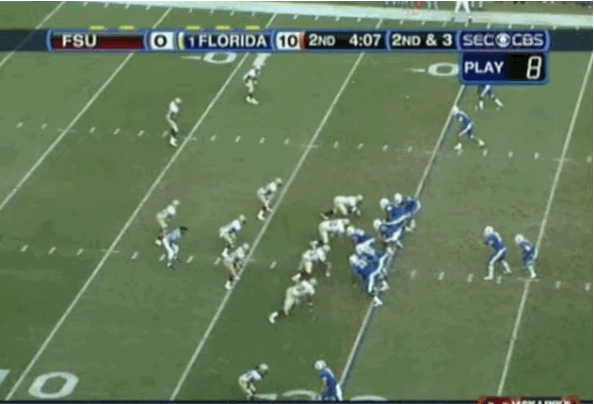
The concept gives the offense three potential ball-carriers, which is a great solution for a unit like the 2015 Buckeyes who feature more than a handful of dangerous runners with the ball in their hands. But although tight ends Nick Vannett and Marcus Baugh might be talented players in their own right, they probably don't strike fear in the hearts of defenders when running in the open field the same way Marshall and Samuel might.
One of the issues with the Buckeye offense throughout much of the season was a stated devotion to getting touches for the many play-makers on offense, which often ran counter to the natural flow of the play-calling. By implementing a more option-focused attack that put any number of dangerous runners in a position to pick up yardage based solely on the defense's reaction, the Buckeyes could much better balance this desire.
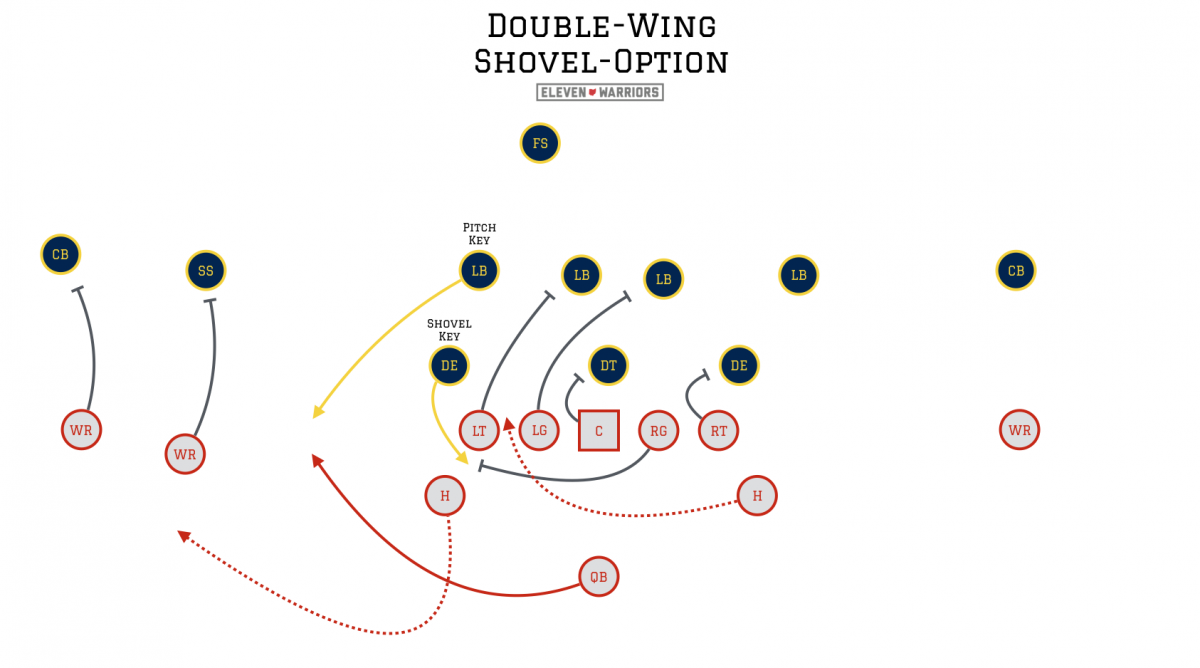
Marshall lined up in this case as the "shovel" option, coming across the option from right to left. Meanwhile, Samuel backpedaled to get depth at the snap, looking to get one yard behind and five yards wide of Barrett as the quarterback rolled left. To make his decision, Barrett first reads defensive end Chris Wormley (#43), who is left unblocked. As Wormley steps down out of instinct to take away any inside action, Barrett knows the shovel isn't there.
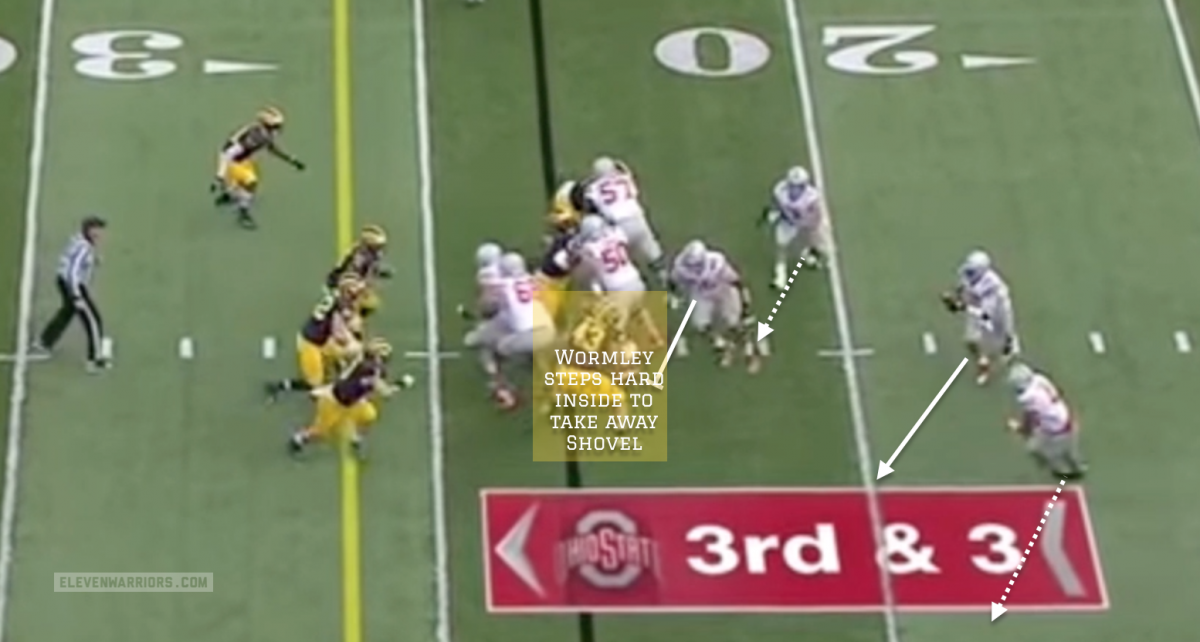
However, as the linebackers read the 'Power' blocking scheme from the line with the pulling guard, they are late to get outside where Barrett is waiting for the other unblocked player, Desmond Morgan (#3) to decide whether to take on either the quarterback or the pitch-man.
Barrett intentionally gains more width than depth in his route around the outside, preparing to potentially cut back against the grain should the defense play the pitch man. His eyes are on the outside shoulder of Morgan, waiting to see him turn and square up to make the tackle. As soon as the quarterback sees this motion from the optioned defender, it's time to pitch outside.
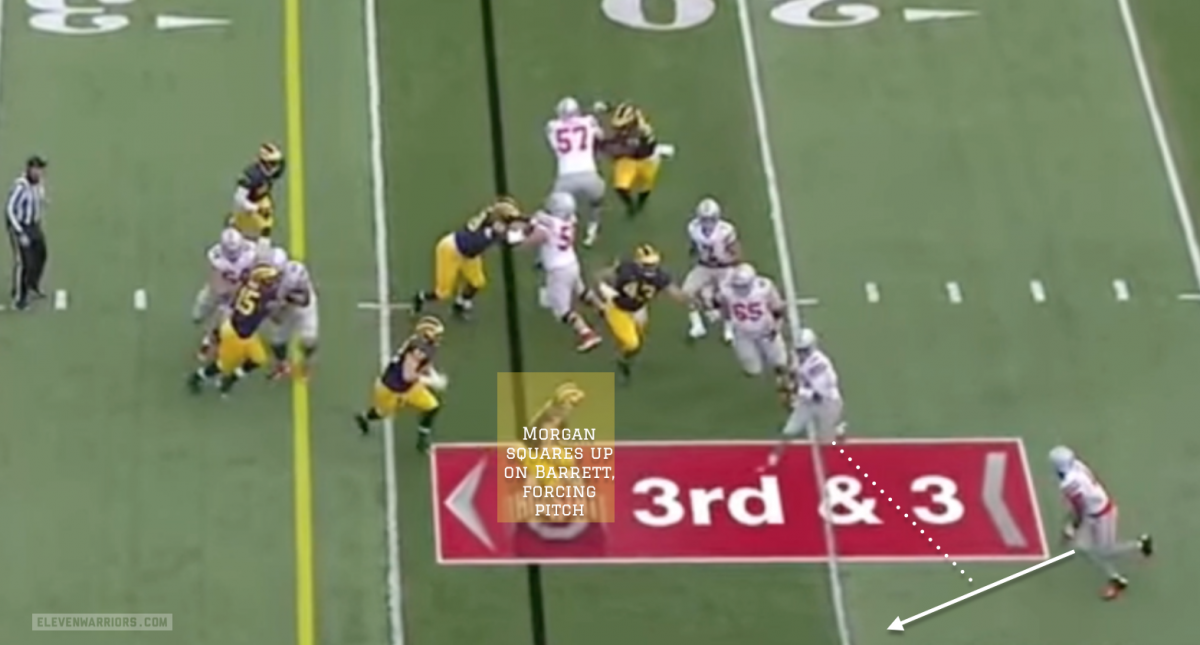
As interesting and innovative as this concept may be, there must be counters to it in order to keep the defense on its toes. Meyer was able to hide the triple/shovel-option in Florida by running it from base formations where countless other concepts could be called. This look from the Buckeyes though would be a dead giveaway the next time it shows up on the field, meaning additional plays must be added to the package.
But just three plays later the Buckeyes would line up in the same look, this time bringing one of the wings in motion behind the QB before the snap and once again appearing to be an option to the outside. This would fit the profile of many "Veer" offensive philosophies, balancing a triple-option with a lead-option in which there is no inside give, allowing that player to instead act as a lead-blocker on the outside for the pitch-man.
Yet the Buckeyes didn't actually call for another option on either of the two occasions in which we saw this 'double-wing' look. Instead, the Buckeyes used the motioning wing to suck defenders to the outside while Barrett ran a simple 'Power' play on the inside after faking a pitch.
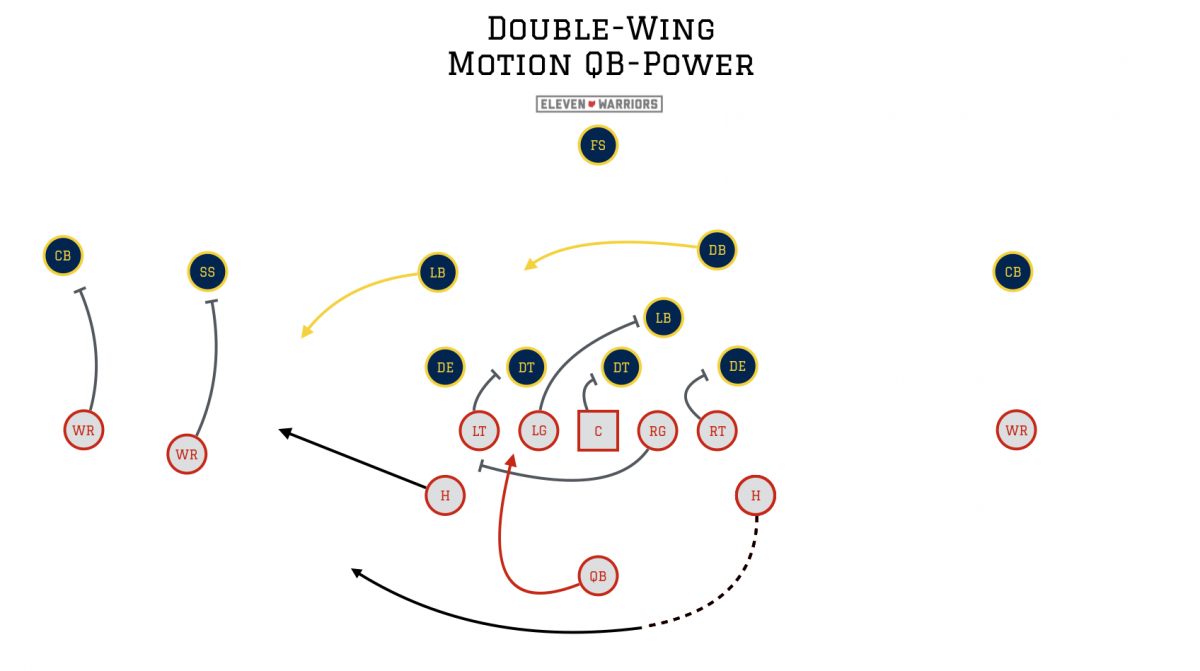
Just as they had on the option, Wormley is left unblocked once again and appears to be the optioned defender. However Barrett waits for his guard to get across the formation and seal the outside edge, kicking out Wormley while the rest of the line sets up a running lane inside.

Barrett certainly makes a great play by juking the linebacker, James Ross (#15), but Ross has no help as his teammates have bit on the outside action from both wings, following them instead of the ball.
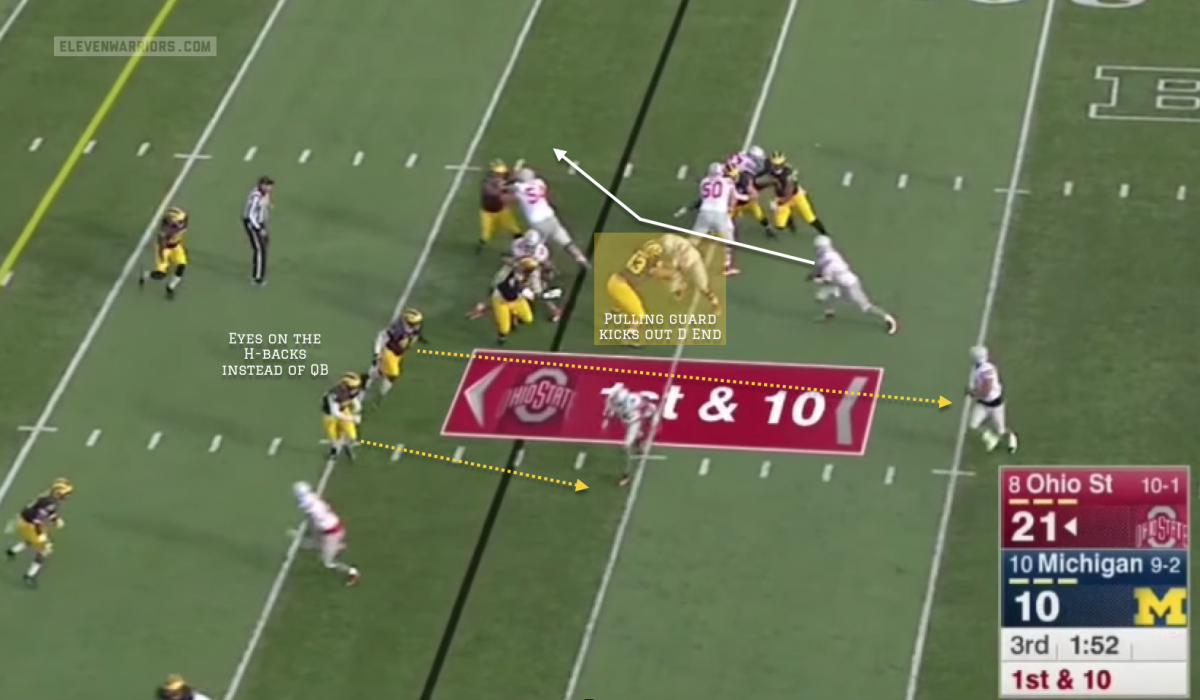
Though Ohio State would only show this package on one drive, running the triple-option once followed by two designed runs for Barrett, the results speak for themselves. The Buckeyes picked up 32 yards on three plays, including a touchdown.
Meyer's offense could run any number of option and toss sweep concepts shown by flexbone teams from this look, but to ensure teams don't simply load the box at the sight of the double-wing, the Buckeyes will be forced to throw the ball from this look as well. Luckily, the formation allows for some clear integration of some passing concepts already found in their playbooks.
With two split receivers and a wing to one side, the Buckeyes could easily integrate flood concepts such as 'Sail' which gives the quarterback an easy deep-to-short read of three receivers to one side as he rolls out.

Due to issues on the right side of the offensive line, Barrett is already used to rolling out with a guard to lead him in pass protection, sealing the front-side of a moving pocket. Not only does this rolling action get Barrett outside and able to take off if his receivers are covered, the pulling guard helps sell the play as another shovel pass or inside "Power" run, sucking up defenders.
Looking toward both the upcoming matchup with Notre Dame on New Year's Day and the 2016 season, the package could be a big part of the OSU offense moving forward. The unit has been at its best when Barrett has been able to run the ball inside, something every opponent surely knows at this point.
Add in the expected departure of Elliott and the Buckeye running game may have to re-invent itself in the near future. Even if Marshall leaves for the NFL this winter as well, a healthy Dontre Wilson could easily fill the role of the other wing player. Regardless of when we see it again, the double-wing could be a valuable addition to the Meyer's playbook, not only because of its initial success, but rather for its ability to be many things without appearing so at first.


